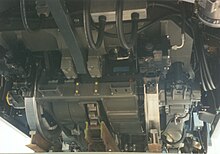BZB No. 12 to 16 (railcars)
| Railcar 12 to 16 | |
|---|---|
| Numbering: | 12, 14, 15, 16 |
| Number: | 4th |
| Axis formula : | Bo'Bo'Bo ' |
| Gauge : | 1000 mm ( meter gauge ) |
| Length over coupling: | 30,600 mm |
| Width: | 2500 mm |
| Bogie axle base: | 2720 mm |
| Empty mass: | 65.4 t |
| Top speed: | 70 km / h |
| Starting tractive effort: | 300 kN |
| Driving wheel diameter: | 875 mm (new) / 845 mm (worn) |
| Power system : | 1650 V DC |
| Power transmission: | Overhead line |
| Number of traction motors: | 6th |
| Coupling type: | Scharfenberg coupling |
| Seats: | 106 |
| Standing room: | 74 |
The double multiple units 12 to 16 of the Bayerische Zugspitzbahn are meter-gauge electric multiple units for mixed adhesion and cogwheel operation, which were supplied by Stadler Rail .
history
In 2006, the vehicle fleet was significantly modernized with the four twin multiple units 12, 14, 15 and 16. Like the double railcars 10 and 11, these railcars can travel the entire route. The vehicles supplied by Stadler Rail under the serial numbers L4122 / 1 to L4122 / 4 have an output of six times 300 kilowatts, the maximum speed corresponds to the 10 and 11 double railcars .
On June 22, 2006, the first of these double multiple units was delivered to Garmisch on three low-loaders , and the first public trip took place on October 8, 2006. The vehicles were ordered shortly before Christmas 2003.
Together with railcars 10 and 11, the railcars handle the main load on the route. This enabled railcars 1 to 4 to be taken out of service.
technology
At the front, the vehicles were given doors, which are always arranged on the left-hand side, seen in the direction of travel, in order to ensure that the vehicle can also be evacuated in the tunnel. The vehicle is powered by three motor bogies, each with two drive axles with adhesion and gear drive. The drive consists of three IGBT converters and six self-ventilated asynchronous motors . The car body is supported by air springs on the bogies, the middle one being designed as a Jakobs bogie . There is a transition option between the two car parts. A regenerative resistance brake is used as the service brake , plus an adhesive block brake for all six wheel sets and two independently acting pneumatic gear brakes, which each act on all six drive gears.
The double railcars are able to transport a braked front car with a mass of 20 tons and unbraked front car with 13.5 tons. In addition, the double railcars are capable of double traction with each other, but not with the older double railcars 10 and 11.
In order to increase the comfort of the passengers, the railcars were equipped with compact air-conditioning units and a passenger information system. The railcars also have a fire alarm and fire fighting system.
Web links
Individual evidence
- ↑ New railcars for the Zugspitzbahn . In: Eisenbahn-Revue International . No. 2 . MINIREX AG, February 2004, ISSN 1421-2811 , p. 63 .
- ↑ Vehicle list of the Bavarian Zugspitzbahn. (PDF) (No longer available online.) March 2, 2012, archived from the original on March 2, 2012 ; accessed on December 12, 2017 .
- ^ Rainer Weber, Anton Zimmermann: The Bavarian Zugspitzbahn and its new vehicles . In: Eisenbahn Revue International . No. 8-9 . MINIREX AG, August 2007, ISSN 1421-2811 , p. 409-415 .
- ^ Rainer Weber, Anton Zimmerman: The Bavarian Zugspitzbahn and its new vehicles . In: Eisenbahn Revue International . No. 10/2007 . MINIREX AG, October 2007, ISSN 1421-2811 , p. 510-515 .
- ↑ Data sheet gear and adhesion double railcars. (PDF) Stadler Rail, accessed on March 12, 2018 .

